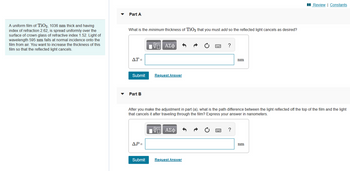Question

Transcribed Image Text:### Thin Film Interference Problem
A uniform film of TiO₂, 1036 nm thick and having an index of refraction 2.62, is spread uniformly over the surface of crown glass with a refractive index of 1.52. Light of wavelength 595 nm falls at normal incidence onto the film from air. The goal is to increase the thickness of this film so that the reflected light cancels.
#### Part A
**Question:**
What is the minimum thickness of TiO₂ that you must add so the reflected light cancels as desired?
**Input Box for Answer:**
ΔT = ______ nm
**Options:**
- Submit
- Request Answer
---
#### Part B
**Question:**
After you make the adjustment in Part A, what is the path difference between the light reflected off the top of the film and the light that cancels it after traveling through the film? Express your answer in nanometers.
**Input Box for Answer:**
ΔP = ______ nm
**Options:**
- Submit
- Request Answer
---
This exercise requires understanding of the principles of thin film interference, where light waves reflecting off the top and bottom surfaces of a film can interfere destructively, leading to the cancellation of specific wavelengths.
![**Part C**
Express your answer in wavelengths of the light in the TiO₂ film.
ΔP = [ ]
[Submit] [Request Answer]
---
This text prompt appears in the context of a physics or materials science problem, likely involving thin film interference or refraction. The question asks you to provide an answer in terms of wavelengths specific to the titanium dioxide (TiO₂) film. The interface provides options to input mathematical or symbolic expressions.
No graphs or diagrams are included in the image.](https://content.bartleby.com/qna-images/question/b10c217e-0837-4d3f-89c5-6d9b36b54f81/956d308a-f6f9-49a6-8c04-1a66ef3c038f/8ggujmf_thumbnail.png)
Transcribed Image Text:**Part C**
Express your answer in wavelengths of the light in the TiO₂ film.
ΔP = [ ]
[Submit] [Request Answer]
---
This text prompt appears in the context of a physics or materials science problem, likely involving thin film interference or refraction. The question asks you to provide an answer in terms of wavelengths specific to the titanium dioxide (TiO₂) film. The interface provides options to input mathematical or symbolic expressions.
No graphs or diagrams are included in the image.
Expert Solution
This question has been solved!
Explore an expertly crafted, step-by-step solution for a thorough understanding of key concepts.
This is a popular solution
Trending nowThis is a popular solution!
Step by stepSolved in 2 steps with 2 images

Knowledge Booster
Similar questions
- White light originates in water (n = 1.33) and then passes through crown glass, which has mild dispersion behavior (nred = 1.52, nviolet = 1.53). What initial angle above the horizontal in water would be required for the glass to refract red light but internally reflect the violet light? Assume the glass is in contact with air above it. What would be the angle of refraction for red light at the glass-air interface? Air Glass Waterarrow_forwardThe refraction indices of materials vary slightly with temperature and with the wavelength of the light going through the material. The index of refraction of water at 70°C for a helium neon laser is 1.32% (use the fraction-no calculators). If the laser is shone through a right triangular prism of water (held by in place by negligibly thin walls) as drawn, What is the critical value of the angle of incidence, 8₁, such that beyond this angle, the laser is not transmitted through the far side as indicated? 8₂ Buc= Does total internal reflection occur for incident angles greater than or less than 8?arrow_forwardA plane sound wave in air at 20°C, with wavelength 589 mm, is incident on a smooth surface of water at 25°C at an angle of incidence of 12.3°. (a) Determine the angle of refraction for the sound wave. (b). Determine, the wavelength of the sound in water. Enter a number with units. A narrow beam of sodium yellow light, with wavelength 589 nm in vacuum, is incident from air onto a smooth water surface at an angle of incidence of 12.3o. (c) Determine the angle of refraction. (d) Determine the wavelength of the light in water.arrow_forward
- A convex lens is used to focus light waves to a pointwithin its focal length. The convex lens chosen has a refractive index is 1.5.This lens is placed over a glass plate in such a way it receives the incidentlight normally. What will be the radius of the 6th dark circle inthe achieved interference pattern of reflected rays from the air film created.Assuming the radius of curvature as 4m. The wavelength of the incident light is5890*10^-10marrow_forwardMourning doves have a small batch of iridescent feathers. The color isproduced by a 260-nm-thick layer of keratin (n = 1.56), with air on both sides that are found around the edge of the feather barbules. A mutant species of the mourning dove discussed above has the side ofthe keratin layer facing away from the incident light bound to a thin hard layer of material of index of refraction similar to that of diamond (n = 2.42). Both keratin and diamondlike material have thicknesses of 260nm. For what visible wavelength (or wavelengths) would this structure produce constructive interference? A) 1622nm, 811nm, 406nmB) 686nm, 541nm, 412nmC) 406nmD) 541nmE) 686nm, 412nmarrow_forwardA plastic light pipe has an index of refraction of 1.51. For total internal reflection, what is the minimum angle of incidence if the pipe is in the following media? (a) air (b) water O Oarrow_forward
arrow_back_ios
arrow_forward_ios